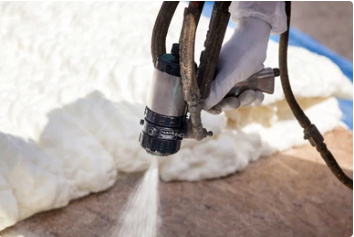Exploring the World of Spray Foam Insulation: Types and Applications
Exploring the World of Spray Foam Insulation: Types and Applications

What is Spray Foam Insulation?
Spray foam insulation is a versatile material that is used to seal and insulate buildings. It is created by mixing two components - polyol resin and isocyanate - which react and expand when sprayed. The resulting foam fills gaps and crevices, effectively creating a continuous barrier against air infiltration and heat transfer.
Open-Cell Spray Foam Insulation
Characteristics
Open-cell spray foam insulation is a lightweight material that expands to fill spaces and create a soft, spongy texture. It is known for its high expansion rate and superior sound-absorbing qualities. Open-cell foam is water- and vapor-permeable, making it ideal for moisture management.
Applications
Open-cell spray foam is often used in interior applications, including walls and ceilings. It is an excellent choice for soundproofing and is suitable for attic and crawl space insulation. Due to its open-cell structure, it is not recommended for areas prone to moisture, such as basements.
Closed-Cell Spray Foam Insulation
Characteristics
Closed-cell spray foam insulation is dense and rigid, with a low expansion rate. It has a high insulation value and serves as an effective air and vapor barrier. Closed-cell foam is resistant to water and offers exceptional strength and durability.
Applications
Closed-cell spray foam is versatile and can be used in various applications. It is ideal for exterior use, including roofs, walls, and foundations. Its ability to provide a moisture barrier makes it suitable for basements and other areas susceptible to water infiltration. It's also commonly used in commercial and industrial settings.
Medium-Density Spray Foam Insulation
Characteristics
Medium-density spray foam insulation offers a balance between open-cell and closed-cell foams. It provides good insulation properties while maintaining some flexibility. This type of foam is often used for sound insulation and is moderately resistant to moisture.
Applications
Medium-density spray foam can be applied to various areas, including walls, roofs, and floors. It's a popular choice for insulating residential homes, especially in regions with moderate climate conditions.
High-Density Spray Foam Insulation
Characteristics
High-density spray foam insulation is rigid and has a very low expansion rate. It provides exceptional insulation, high strength, and resistance to moisture. This type of foam is often used for specialized applications.
Applications
High-density spray foam is employed in demanding applications, such as insulating commercial refrigeration systems, metal buildings, and even for some structural support. It is less common in residential projects due to its specialized nature.
Biodegradable and Environmentally Friendly Spray Foam Insulation
Characteristics
In recent years, environmentally friendly spray foam insulation options have become available. These formulations often use renewable or biodegradable materials. They aim to reduce the environmental impact of insulation products.
Applications
Biodegradable and eco-friendly spray foam insulation is suitable for residential and commercial use. It offers the same insulation benefits as traditional foam while minimizing the impact on the environment.
Spray Foam Kits for DIY Enthusiasts
For those who enjoy tackling home improvement projects themselves, spray foam kits are available. These kits typically include the necessary components and equipment for applying spray foam insulation. They are convenient for smaller-scale projects like sealing gaps and insulating specific areas.
Choosing the Right Spray Foam Insulation for Your Project
When selecting the right spray foam insulation for your project, consider factors such as the climate, the area to be insulated, and your budget. Closed-cell foam is ideal for moisture-prone areas, while open-cell foam is cost-effective for interior spaces. Medium-density foam offers a compromise between the two, and environmentally friendly options are available for those looking to reduce their carbon footprint.
Advantages and Considerations
Advantages of spray foam insulation include excellent insulation, moisture resistance, and long-term energy savings. However, it is essential to consider factors like cost, installation by trained professionals, and potential health and environmental concerns associated with the chemicals used in spray foam.
Conclusion
Spray foam insulation comes in various types, each with unique characteristics and applications. Understanding the differences between open-cell, closed-cell, medium-density, high-density, and environmentally friendly options can help you make an informed decision for your insulation project. Whether you are insulating your home, a commercial space, or a DIY project, the right type of spray foam can provide you with energy efficiency, comfort, and peace of mind.


